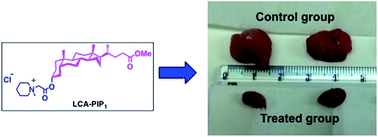Synthesis, structure–activity relationship, and mechanistic investigation of lithocholic acidamphiphiles for colon cancer therapy†
Abstract
We report a structure–activity relationship of

* Corresponding authors
a
The Laboratory of Nanotechnology and Chemical Biology, Regional Centre for Biotechnology, 180 Udyog Vihar, Phase 1, Gurgaon-122016, Haryana, India
E-mail:
bajaj@rcb.res.in
Fax: +91-124-4038117
Tel: +91-124-2848831
b National Institute of Immunology, Aruna Asif Ali Marg, New Delhi 110067, India
c Manipal University, Manipal, Karnatka, India
We report a structure–activity relationship of

 Please wait while we load your content...
Something went wrong. Try again?
Please wait while we load your content...
Something went wrong. Try again?
M. Singh, S. Bansal, S. Kundu, P. Bhargava, A. Singh, R. K. Motiani, R. Shyam, V. Sreekanth, S. Sengupta and A. Bajaj, Med. Chem. Commun., 2015, 6, 192 DOI: 10.1039/C4MD00223G
To request permission to reproduce material from this article, please go to the Copyright Clearance Center request page.
If you are an author contributing to an RSC publication, you do not need to request permission provided correct acknowledgement is given.
If you are the author of this article, you do not need to request permission to reproduce figures and diagrams provided correct acknowledgement is given. If you want to reproduce the whole article in a third-party publication (excluding your thesis/dissertation for which permission is not required) please go to the Copyright Clearance Center request page.
Read more about how to correctly acknowledge RSC content.
 Fetching data from CrossRef.
Fetching data from CrossRef.
This may take some time to load.
Loading related content
